Do Phytochromes and Phytochrome-Interacting Factors Need to Interact?
IN BRIEF by Nancy R. Hofmann [email protected]
A new study calls into question whether phytochrome B (phyB) must directly interact with phytochrome-interacting factors (PIFs) to promote light responses. Phytochrome photoreceptors mediate responses to red light in part by inducing the degradation of PIF transcription factors, which generally are repressors of light responses (reviewed in Jeong and Choi, 2013; Wang and Wang, 2015). As the name implies, PIFs can directly interact with phytochromes, and it has been suggested that interaction between light-activated phytochromes and PIFs in foci called nuclear bodies leads to PIF degradation.
There are five phytochromes in Arabidopsis thaliana, with phyB the main form present in plants grown in the light. Although phyB seems to be expressed ubiquitously, there is some evidence that phyB effects may not be cell-autonomous, and certain downstream responses to red light perception by phyB must involve signaling between cells and between tissues. New work from Kim et al. (2016) suggests that several effects mediated by phyB can be attributed to phyB in the epidermis.
To determine the site(s) of action of phyB, Kim and coworkers characterized transgenic Arabidopsis lines expressing a phyB-GFP fusion from tissue-specific promoters. The success of this approach requires exquisitely specific promoters, and the authors found the MERISTEM LAYER1 (ML1) promoter (ML1pro) and the SCARECROW (SCR) promoter (SCRpro) to be suitable for analysis of expression in the epidermis and the endodermis, respectively (see figure). phyB-GFP expressed from ML1pro rescued the phyB mutant in terms of both seed germination and inhibition of hypocotyl elongation in response to red light. Importantly, however, expression driven from SCRpro did not rescue the mutant, indicating that epidermal, but not endodermal, phyB is responsible for these phyB functions.
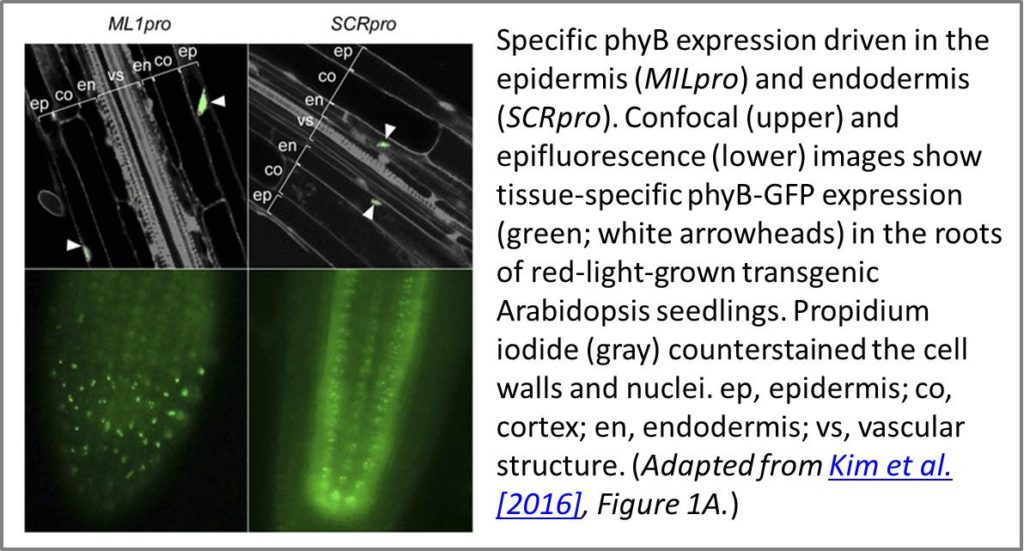
To explore the notion of a non-cell-autonomous function for epidermal phyB, Kim et al. used the negative gravitropic response of the hypocotyl as a model system. The inhibition of this response by phyB is likely mediated by endodermal PIFs, as the expression of PIF1 in the endodermis can rescue the response in the pifQ quadruple mutant (Kim et al., 2011). Again, epidermal, but not endodermal, phyB-GFP restored the inhibition of negative gravitropism. Furthermore, epidermal phyB-GFP induced the phosphorylation and degradation of endodermal PIFs, lending more support to the conclusion that epidermal phyB provokes non-cell-autonomous responses. Finally, Kim and coworkers provide evidence that epidermis-specific expression of phyB, despite its difference from the endogenous phyB expression pattern, is sufficient to regulate the expression of nearly all phyB-responsive genes in Arabidopsis.
This work gives rise to a number of questions, including what mechanism could account for phyB-induced degradation of PIFs in a different cell layer. It is conceivable that the expression driven by the epidermal promoters in these experiments included some expression in other tissues below the level of GFP detection, as has been suggested in analysis of PHOTOTROPIN function (Sullivan et al., 2016); however, it is not clear how this would explain the observation that endodermal expression of phyB was insufficient to rescue phyB functions. An intriguing next step will be to investigate whether (and what) mobile signals are generated by epidermal phyB.
REFERENCES
Jeong, J., and Choi, G. (2013). Phytochrome-interacting factors have both shared and distinct biological roles. Mol. Cells 35: 371–380.
Kim, J., Song, K., Park, E., Kim, K., Bae, G., and Choi, G. (2016). Epidermal phytochrome B inhibits hypocotyl negative gravitropism non-cell-autonomously. Plant Cell 28: 2770–2785.
Kim, K., Shin, J., Lee, S.H., Kweon, H.S., Maloof, J.N., and Choi, G. (2011). Phytochromes inhibit hypocotyl negative gravitropism by regulating the development of endodermal amyloplasts through phytochrome-interacting factors. Proc. Natl. Acad. Sci. USA 108: 1729–1734.
Sullivan, S., Takemiya, A., Kharshiing, E., Cloix, C., Shimazaki, K.I., and Christie, J.M. (2016). Functional characterisation of Arabidopsis phototropin 1 in the hypocotyl apex. Plant J. 88: 907–920.
Wang, H., and Wang, H.Y. (2015). Phytochrome signaling: time to tighten up the loose ends. Mol. Plant 8: 540–551.


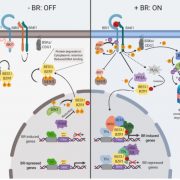
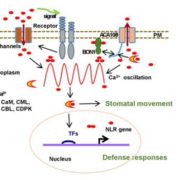
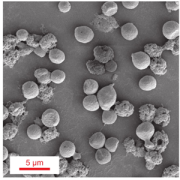
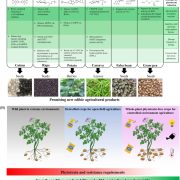

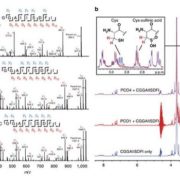


Leave a Reply
Want to join the discussion?Feel free to contribute!